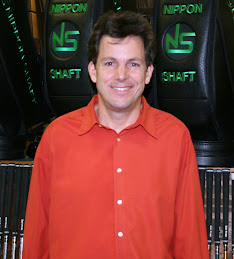
QUESTION: Hi,I’m now playing 2009 Burner with 49G, 45′ shaft, Reg flex.I hit it about 200-210 regularly. No problem with gettingthe ball in the air, but I would like more distance. Don’t get much roll. Need more swing speed. Will a longer shaft (46′-47′-48′) help? How about more flex? Current swing speed, controlled swing, in balance,
is 86-88mph. Thanks, JW
ANSWER: Hi JW,
Please understand that there are specific reasons, based
on the physics of your clubhead delivery, and the physics of
your equipment, as to why your ball flies like it does.
There is no “ONE” answer to your questions. But, based on
your note, here are a few comments to get you started
thinking in the right direction-
1) Your lack of roll is most assuredly the result of a
head delivery at impact in a downward angle. This creates
a spin that adds to a rising type trajectory, and subtracts
from distance gaining roll. You may consider working with a
teaching professional to change how you deliver your driver
at impact. Choose a pro wisely, as most do not understand
the physics of this collision moment. If your teaching pro
employs the use of a TRACKMAN system, they most likely are
aware of what I am writing about.
2) You might consider experimenting with different models of
driver heads. Finding a lower spinning head, and maybe even
more loft, is often found to be of great benefit.
3) If your shaft is too stiff for your swing- this will hold
back your distance. The only definitive method is to test and
compare different shaft models. You might consider contacting
one or two of our Authorized Installation Centers and inquire
as to the testing and fitting services that they offer. Their
contact information can be found at www.shaftology.com.
4) Regarding using longer length clubs? This is typically a
disaster for golfers who deliver their driver in a downward
angle at impact. This extra length is in severe conflict
with their swing type and results in bad, adaptive type
swing efforts, and thus poor contact and control.
5) If you are able to use a longer length driver shaft,
you will have to marry this concept with a lighter head.
A longer club with a standard weight driver head will
typically feel out of balance. You might want to connect
with one of our Authorized Installation Centers that are
also a Taylor Made Center, as many of their heads are
weight adjustable. Other options include some of our
Centers who are also Adams centers, that offer some
relevant fitting options.
6) Several companies are offering lighter, longer
drivers, that may or may not be of benefit, but are
worth investigating. One of these is the new Cleveland
DST driver series.
Many of these concepts can be confusing, and I heartily
recommend that you seek help with your search.
In summary, if you are able to combine the benefits of
learning a more functional head delivery, the use of
longer shafts, equipped with a lighter shaft model, like
our NS PRO WT5000, possibly a lower spinning head, and a
lighter head, you will be on your way to discovering which
combination of swing, shaft, and club specifications gives
you the best chance for maximum distance.
Regards, Mark







